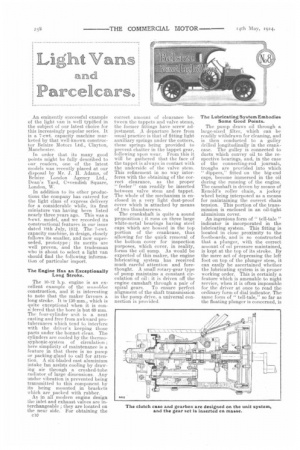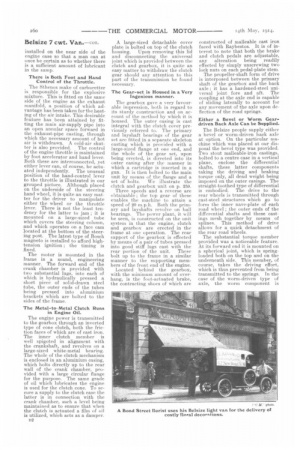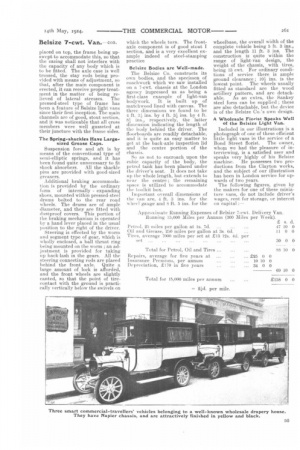ana
Page 14

Page 16

Page 17

If you've noticed an error in this article please click here to report it so we can fix it.
and
Farce czToo
An eminently successful example of the light van is well typified in the subject of our latest choice for this increasingly popular series. It is a 7-cwt. capacity machine marketed by that well-known constructor Belsize Motors Ltd., Clayton, Manchester.
In order that its many good points might be fully described to our readers, one of the latest models was recently placed at our disposal by Mr. J. H. Adams, of Belsize London Agency Ltd., Dean's Yard, CRvendish Square, London, W.
In addition to its other productions the company has catered for the light class of express delivery for a considerable while, its first miniature van having been listed nearly three years ago. This was a 5-cwt. model, and we recorded its constructional features in our issue dated 18th July, 1912. The 7-cwt. capacity machine, in design, closely follows its smaller, and now superseded, prototype ; its merits are well proven, and the tradesman who is about to select a light van should find the following information of particular import.
The Engine Has an Exceptionally Long Stroke.
The 10-12 h.p. engine is an excellent example of the niollohloc construction, and it is interesting to note that the maker favours a long stroke. It is 130 mm., which is quite exceptional when it is cons!lered that the bore is but 69 mm. The four-cylinder unit is a neat casting and free from awkward protuberances which tend to interfere with the driver's keeping those parts under the bonnet clean. The cylinders are cooled by the therniosyphonic-system of circulation ; here simplicity of maintenance is a feature in that there is no pump or packing-gland to call for attention. A six-bladed cast aluminium intake fan assists cooling by drawing air through a crushed-tube radiator of large dimensions. Any undue vibration is prevented being transmitted to this component by its being mounted in brackets which are packed with rubber. As in all modern engine design the inlet and exhaust valves are interchangeable; they are located on the near side. For obtaining the
do correct amount of clearance between the tappets and valve stems, the former fittings have screw adjustment. A departure here from usual practice is that of fitting light auxiliary springs under the cotters, these springs being provided to prevent chatter in the tappet gear, following upon wear. From this it will be gathered that the face of the tappet is always in contact with the underside of the valve stem. This refinement in no way interferes with the obtaining of the correct clearance, as the proper " feeler" can readily be inserted between valve stem and tappet. The whole of the mechanism is enclosed in a very light dust-proof cover which is attached by means of two thumbscrews.
The crankshaft is quite a sound proposition ; it runs on three large white-metal bearings having steel caps which are housed in the top portion of the crankcase, thus allowing for the quick removal of the bottom cover for inspection purposes, which cover, in reality, forms the oil sump. As would be expected of this maker, the engine lubricating system has received much careful attention and forethought. A small rotary-gear type of pump maintains a constant circulation of oil it is driven off the engine camshaft through a pair of
spiral gears. To ensure perfect alignment of the shaft transmission in the pump drive, a universal connection is provided.
The Lubricating System Embodies Some Good Points.
The pump draws oil through a large-sized filter, which can be readily withdrawn for cleaning, and is then conducted to a gulley drilled longitudinally in the crankcase. The gulley is connected to ducts which convey oil to the respective bearings, and, in the case of the connecting-rod journals, troughs are provided into which " dippers," fitted on the big-end caps, become immersed in the oil during the running of the engine. The camshaft is driven by means of Renold's roller chain, a jockey wheel being interposed as a means for maintaming the correct chain tension. This portion of the transmission is enclosed in an oil-tight aluminium cover.
An ingenious form of " tell-tale " indicator is incorporated in the lubricating system. This fitting is located in close proximity to the footboards, and is so constructed that a plunger, with the correct amount of oil pressure maintained, is kept at the top of its stroke. By the mere act of depressing the left foot on top of the plunger stem, it can easily be ascertained whether the lubricating system is in proper working order. This is certainly a feature which is amenable to night service, when it is often impossible for the driver at once to read the ordinary form of dial indicator. The same form of " tell-tale," so far as the floating plunger is concerned, is installed on the near side of the engine case so that a man can at once be certain as to whether there is a sufficient amount of lubricant in the sump.
There is Both Foot and Hand Control of the Throttle.
The Sthenos make of carburetter is responsible for the explosive mixture. This is fitted on the same side of the engine as the exhaust manifold, a position of which advantage has been taken for the heating of the air intake. This desirable feature has been attained by fitting the main air-supply pipe into an open annular space forward in the exhaust-pipe casting, through which the necessary amount of hot air is withdrawn. A cold-air shutter is also provided. The control of the engine throttle is maintained by foot accelerator and hand lever. Both these are interconnected, yet either lever can, of course, be actuated independently. The unusual position of the hand-control lever to the throttle is illustrated in our grouped picture. Although placed on the underside of the steering hand wheel, it is quite an easy matter for the driver to manipulate either the wheel or the throttle lever. There is not the least tendency for the latter to jam ; it is mounted on a large-sized tube which covers the steering column, and which operates on a face cam located at the bottom of the steering post. The latest type of Bosch magneto is installed to afford high-tension ignition ; the timing is .fixed.
The motor is mounted in the frame in a sound, engineering manner. The forward end of the crank chamber is provided with two substantial lugs, into each of which is hydraulically pressed a short piece of solid-drawn steel tube, the. outer ends of the tubes being pressed into aluminium brackets which are bolted to the sides of the frame.
The Metal-to-Metal Clutch Runs in Engine OH.
The engine power is transmitted to the gearbox through an inverted type of cone clutch, both the friction faces of which are of cast iron. The inner clutch member is well spigoted in alignment with the crankshaft, and revolves on a large-sized white-metal bearing. The whole of the clutch mechanism is enclosed in an aluminium casing, which bolts directly up to the rear wall of the crank chamber, provided with a large circular flange for the purpose. The same grade of oil which lubricates the engine is used for the clutch cone. To secure a supply to the clutch case the latter is in connection with the crank chamber, such a level being maintained as to ensure that when the clutch is actuated a film of oil is utilized, which acts as a damper. D2
A large-sized detachable cover plate is bolted on top of the clutch housing. Upon removing this lid and disconnecting the universal joint which is provided between the clutch and gearbox, it is quite an easy matter to withdraw the clutch gear should any attention to this part of the transmission be found necessary.
The Gear-set is Housed in a Very Ingenious manner.
The gearbox gave a very favourable impression, both in regard to its sturdy construction and on account of the method by which it is housed. The outer casing is cast integral with the clutch cover previously referred to. The primary and layshaft bearings of the gear set are fitted in a separate skeleton casting which is provided with a large-sized flange at one end, and the whole of the gear set, upon being erected, is directed into its outer casing after the manner in which a cartridge is inserted in a gun. It is then bolted to the main unit by means of the flange and a set of bolts. We illustrate the clutch and gearbox unit on p. 259.
Three speeds and a reverse are obtainable ; the top gear of these enables the machine to attain a speed of 20 m.p.h. Both the primary and layshafts revolve on ball bearings. The power plant, it will be seen, is constructed on the unit system in that the engine, dutch and gearbox are erected in the frame at one operation. The rear support of the gearbox is effected by means of a pair of tubes pressed into good atiff lugs cast with the rear portion of the unit. These bolt up to the frame in a similar manner to the supporting members of the front end of the engine.
Located behind the gearbox, with the minimum amount of overhang, is the foot-actuated brake, the contracting shoes of which are constructed of malleable cast iron faced with Raybestos. It is of interest to note that both the brake and clutch pedals are adjustable, any alteration being readily effected by simply unscrewing two lock nuts on each pedal-plate stem.
The propeller-shaft form of drive is interposed between the primary shaft of the gearbox and the back axle ; it has a hardened-steel universal joint fore and aft. The coupling at the axle end is capable of sliding laterally to account for any movement of the axle upon deflection of the road springs.
Either a Bevel or Worm Gear. driven Back Axle Can be Supplied.
The Belsize people supply either a bevel or worm-driven back axle at option. On the particular machine which was placed at our disposal the bevel type was provided. Two stout malleable-iron castings, bolted to a centre case in a vertical plane, enclose the differential shafts, these latter components taking the driving and braking torque only, all dead weight being imposed on the outer casings. The straight-toothed type of differential is embodied. The drive to the rear wheels is transmitted through cast-steel structures which go to form the inner nave-plate of each road wheel ; the outer ends of the differential shafts and these castings mesh together by means of splines. This method of drive allows for a quick detachment of the rear road wheels.
The substantial torque member provided was a noticeable feature. At its forward end it is mounted on a spherical joint, which is springloaded both on the top and on the underneath side. This member, of course, takes the driving effort, which is thus prevented from being transmitted to the springs. In the case of the worm-driven type of axle, the worm component is
placed on top, the frame being upswept to accommodate this, so that the casing shall not interfere with the capacity of any body which is to be fitted. The axle case is well trussed, the stay rods being provided with means of adjustment, so that, after the main component is erected, it can receive proper treatment in the matter of being relieved of lateral stresses. The pressed-steel type of frame has been a feature of Belsize light vans since their first inception. The main channels are of good, stout section, and it was noticeable that all cross members were well gusseted at their juncture with the frame sides.
The Spring-shackles Have Large. sized Grease Caps.
Suspension fore and aft is by means of the conventional type of semi-elliptic springs, and it has been found quite unnecessary to fit shock absorbers. All the shackle pins are provided with good-sized greasers.
Additional braking accommodation is provided by the ordinary form of internally expanding shoes, mounted within pressed-steel drums bolted to the rear road wheels. The drums are of ample diameter, and they are fitted with dustproof covers. This portion of the braking mechanism is operated by a hand lever placed in the usual position to the right of the driver.
Steering is effected by the worm and segment type of gear, which is wholly enclosed, a ball thrust ring being mounted on the worm ; an adjustment is provided for taking up back-lash in the gears. All the steering connecting rods are placed behind the front axle. Quite a large amount of lock is afforded, and the front wheels are slightly canted, so that the point of tirecontact with the ground is practically vertically below the swivels on
which the wheels turn. The frontaxle component is of good stout I section, and is a very excellent example indeed of steel-stamping practice.
Belsize Bodies are Well-made.
The Belsize Co. constructs its own bodies, and the specimen of coachwork which we saw installed on a 7-cwt. chassis at the London agency impressed us as being a first-class example of light-van bodywork. It is built up of matehwood lined with canvas. The three dimensions we found to be 4 ft. 31 ins. by 4 ft. 3. ins. by 4 ft. 8?, ins., respectively, the latter dimension indicating the length of the body behind the driver. The floorboards are readily detachable, and it is quite an easy matter to get at the back-axle inspection lid and the centre portion of the chassis.
So as not to encroach upon the cubic capacity of the body, the petrol tank has been placed under the driver's seat. It. does not take Lip the whole length, but extends to near the centre ; the remaining space is utilized to accommodate the toolkit box.
Important overall dimensions of the van are, 4 ft. 3 ins, for the wheel gauge and 8 ft, 5 ins, for the wheelbase, the overall width of the complete vehicle being 3 ft. 3 ins., and the length 11 ft. 3 ins. The construction is quite within the range of light-van design, the weight of the chassis, with tires, being 13 cwt. For ordinary conditions of service there is ample ground clearance ; 1O ins, is the lowest point. The wheels usually fitted as standard are the wood artillery pattern, and are detachable. As an extra, the Sankey steel form can be supplied ; these are also detachable, but the device is of the Belsize Co.'s own design.
A Wholesale Florist Speaks Well of the Belsize Light Van. Included in our illustrations is a photograph of one of these efficient little light vans in the service of a
Bond Street florist. The owner, whom we had the pleasure of interviewing, is a satisfied user and speaks very highly of his Belsize machine. He possesses two productions from the Clayton works, and the subject of our illustration has been in London service for upwards of two years. The following figures, given by the makers for one of these miniature vans, do not include driver's wages, rent for storage, or interest on capital :-


























